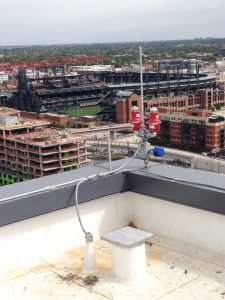Dissecting code language updates to lightning protection systems
-

When completed correctly, lightning protection systems (LPS) integrate effectively with roofing systems. Air terminals or strike termination devices. Strike termination devices, formally known as lightning rods, are installed on high points of a building. Their purpose is to intercept lightning before it hits the building, or a building component, and lead the electrical charge to the ground. Air terminals can be solid, and either pointed or blunt tipped, and are typically made of copper or aluminum alloy.
- Cable conductors. Cable conductors are heavy-duty metal cables that connect the air terminals and other components to provide a path for the lightning current to follow to the below-grade grounding electrode system. Conductor cables are often braided, but can be solid, and are typically made of copper or aluminum.
- Bonding connections. Bonding is the interconnection of the LPS to other internally grounded metallic systems on the structure, such as vent stacks and AC units. Bonding creates a path for lightning current and helps prevent lightning from side-flashing or arching to other metallic systems in the building.
- Grounding electrodes. Grounding electrodes are typically copper-clad steel rods, typically 3 m (10 ft) long, that are connected to the conductors and driven into the ground at multiple points around the building.
- Surge-protection devices. Wherever power or signal wires enter a building, Type 1 surge protection devices specifically configured for lightning must
be installed to stop the intrusion of lightning from utility lines and equalize differences between grounded systems during lightning events.
In addition, according to the LPI, it is also important the LPS is installed, inspected, and certified by a professional trained in installing these systems, and that the installed system meets the standards outlined in NFPA 780, Standard for the Installation of Lightning Protection Systems or in UL 96A, Installation Requirements for Lightning Protection Systems.
Code language updates
The International Building Code (IBC) is updated in multiple steps, based on annual review cycles. In 2021, the Group A Cycle included updates to Chapter 27, which covers “electrical” issues such as LPS. It was during this cycle that language referencing two different standards commonly used by LPS installers—NFPA 780 and UL 96A—was first added to the building code in Chapter 27. While the update does not mandate lightning protection equipment be installed on commercial buildings, it does require compliance with either NFPA 780 or UL 96A when lightning protection equipment is installed.
However, what the update language nor the referenced standards do not cover is how such systems should be secured to existing roofing components. The addition of this language to the 2024 IBC, led by The Single Ply Roofing Industry (SPRI), the trade association representing the manufacturers of single-ply roofing systems and the related component materials, to take action to clarify how LPS components should be secured to edge metal and other tested roofing components. The specific wording added to Section 2703 for the 2024 IBC, under Lightning Protection Systems, reads as follows:








